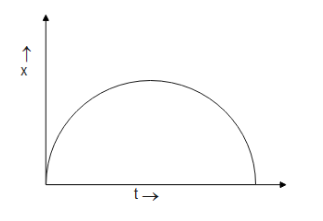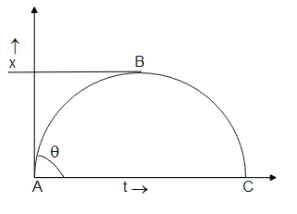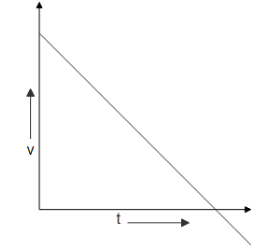
The displacement-time $(x,t)$ graph of a body is given, find the corresponding velocity-time $(v,t)$.


Answer
486.9k+ views
Hint: To plot the velocity-time relation we need to analyze velocity at every point in the displacement-time graph and also have a clear idea about the direction of it since velocity is a vector quantity, it can be negative or positive depending upon its direction.
Complete step by step answer:
Now let us redraw the given diagram for better understanding.

$\overrightarrow v = \dfrac{{d\overrightarrow x }}{{dt}}$ which is the slope of the graph $(x,t)$.As we go from ${\text{A}} \to {\text{B}}$, $\theta $ decreases which means the slope of the plot decreases and thus the velocity decreases. The value of velocity remains positive throughout this path.Now as a point ${\text{B}}$, $\theta $ becomes zero which means the slope of the plot becomes zero and thus the velocity also becomes zero.
As we go further ${\text{B}} \to {\text{C}}$, $\theta $ increases in the negative direction meaning the slope of the plot becomes negative and thus the velocity becomes negative and decreases further. From the above cases, we can now conclude the velocity-time plot, which can be shown as

Note: It should be noted that both velocity and displacement is a vector quantity that has both magnitude as well as direction. For plotting velocity-time or displacement-time, one needs to understand the direction in which it is acting, unlike distance which is a scalar quantity and does not concern the direction involved. Therefore when we say that the distance covered is uniform it only signifies the magnitude, the direction may or may not change but when we say that velocity is uniform, both direction and magnitude remains constant.
Complete step by step answer:
Now let us redraw the given diagram for better understanding.

$\overrightarrow v = \dfrac{{d\overrightarrow x }}{{dt}}$ which is the slope of the graph $(x,t)$.As we go from ${\text{A}} \to {\text{B}}$, $\theta $ decreases which means the slope of the plot decreases and thus the velocity decreases. The value of velocity remains positive throughout this path.Now as a point ${\text{B}}$, $\theta $ becomes zero which means the slope of the plot becomes zero and thus the velocity also becomes zero.
As we go further ${\text{B}} \to {\text{C}}$, $\theta $ increases in the negative direction meaning the slope of the plot becomes negative and thus the velocity becomes negative and decreases further. From the above cases, we can now conclude the velocity-time plot, which can be shown as

Note: It should be noted that both velocity and displacement is a vector quantity that has both magnitude as well as direction. For plotting velocity-time or displacement-time, one needs to understand the direction in which it is acting, unlike distance which is a scalar quantity and does not concern the direction involved. Therefore when we say that the distance covered is uniform it only signifies the magnitude, the direction may or may not change but when we say that velocity is uniform, both direction and magnitude remains constant.
Recently Updated Pages
Why is there a time difference of about 5 hours between class 10 social science CBSE

In cricket, what is a "pink ball" primarily used for?

In cricket, what is the "new ball" phase?

In cricket, what is a "death over"?

What is the "Powerplay" in T20 cricket?

In cricket, what is a "super over"?

Trending doubts
What is meant by exothermic and endothermic reactions class 11 chemistry CBSE

Which animal has three hearts class 11 biology CBSE

10 examples of friction in our daily life

One Metric ton is equal to kg A 10000 B 1000 C 100 class 11 physics CBSE

1 Quintal is equal to a 110 kg b 10 kg c 100kg d 1000 class 11 physics CBSE

Difference Between Prokaryotic Cells and Eukaryotic Cells




